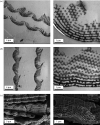Spectral tuning of biotemplated ZnO photonic nanoarchitectures for photocatalytic applications
- PMID: 35845847
- PMCID: PMC9277245
- DOI: 10.1098/rsos.220090
Spectral tuning of biotemplated ZnO photonic nanoarchitectures for photocatalytic applications
Abstract
The photocatalytic activity of a flat surface can be increased by micro- and nanostructuring the interface to increase the area of the contact surface between the photocatalyst and the solute, and moreover, to optimize charge carrier transfer. Further enhancement can be achieved by using photonic nanostructures, which exhibit photonic band gap (PBG). Structurally coloured butterfly wings offer a rich 'library' of PBGs in the visible spectral range which can be used as naturally tuned sample sets for biotemplating. We used conformal atomic layer deposition of ZnO on the wings of various butterfly species (Arhopala asopia, Hypochrysops polycletus, Morpho sulkowskyi, Polyommatus icarus) possessing structural colour extending from the near UV to the blue wavelength range, to test the effects arising from the nanostructured surfaces and from the presence of different types of PBGs. Aqueous solutions of rhodamine B were used to test the enhancement of photocatalytic activity that was found for all ZnO-coated butterfly wings. The best reaction rate of decomposing rhodamine B when illuminated with visible light was found in 15 nm ZnO coated M. sulkowskyi wing, the reflectance of which had the highest overlap with the absorption band of the dye and had the highest reflectance intensity.
Keywords: atomic layer deposition; biotemplating; butterfly wing; photocatalysis; photonic nanoarchitecture; structural colour.
© 2022 The Authors.
Conflict of interest statement
We declare we have no competing interests.
Figures







Similar articles
-
Integrating Cu2O Colloidal Mie Resonators in Structurally Colored Butterfly Wings for Bio-Nanohybrid Photonic Applications.Materials (Basel). 2024 Sep 18;17(18):4575. doi: 10.3390/ma17184575. Materials (Basel). 2024. PMID: 39336316 Free PMC article.
-
Investigating the Effect of Reflectance Tuning on Photocatalytic Dye Degradation with Biotemplated ZnO Photonic Nanoarchitectures Based on Morpho Butterfly Wings.Materials (Basel). 2023 May 7;16(9):3584. doi: 10.3390/ma16093584. Materials (Basel). 2023. PMID: 37176465 Free PMC article.
-
Spectral Engineering of Hybrid Biotemplated Photonic/Photocatalytic Nanoarchitectures.Nanomaterials (Basel). 2022 Dec 19;12(24):4490. doi: 10.3390/nano12244490. Nanomaterials (Basel). 2022. PMID: 36558345 Free PMC article.
-
Biotemplated Morpho Butterfly Wings for Tunable Structurally Colored Photocatalysts.ACS Appl Mater Interfaces. 2018 Feb 7;10(5):4614-4621. doi: 10.1021/acsami.7b14383. Epub 2018 Jan 16. ACS Appl Mater Interfaces. 2018. PMID: 29337532
-
Multi-instrumental techniques for evaluating butterfly structural colors: A case study on Polyommatus bellargus (Rottemburg, 1775) (Lepidoptera: Lycaenidae: Polyommatinae).Arthropod Struct Dev. 2021 Mar;61:101010. doi: 10.1016/j.asd.2020.101010. Epub 2021 Jan 21. Arthropod Struct Dev. 2021. PMID: 33486292 Review.
Cited by
-
Breeding Polyommatus icarus Serves as a Large-Scale and Environmentally Friendly Source of Precisely Tuned Photonic Nanoarchitectures.Insects. 2023 Aug 18;14(8):716. doi: 10.3390/insects14080716. Insects. 2023. PMID: 37623426 Free PMC article.
-
Integrating Cu2O Colloidal Mie Resonators in Structurally Colored Butterfly Wings for Bio-Nanohybrid Photonic Applications.Materials (Basel). 2024 Sep 18;17(18):4575. doi: 10.3390/ma17184575. Materials (Basel). 2024. PMID: 39336316 Free PMC article.
-
Investigating the Effect of Reflectance Tuning on Photocatalytic Dye Degradation with Biotemplated ZnO Photonic Nanoarchitectures Based on Morpho Butterfly Wings.Materials (Basel). 2023 May 7;16(9):3584. doi: 10.3390/ma16093584. Materials (Basel). 2023. PMID: 37176465 Free PMC article.
-
Do dogs understand?-Contrasting anecdotal reports, neuroimaging, and behavioural evidence on language comprehension.Biol Futur. 2025 Jun;76(2):249-257. doi: 10.1007/s42977-025-00275-1. Epub 2025 Jul 8. Biol Futur. 2025. PMID: 40627307 Review.
-
Spectral Engineering of Hybrid Biotemplated Photonic/Photocatalytic Nanoarchitectures.Nanomaterials (Basel). 2022 Dec 19;12(24):4490. doi: 10.3390/nano12244490. Nanomaterials (Basel). 2022. PMID: 36558345 Free PMC article.
References
-
- Byrne C, Subramanian G, Pillai SC. 2018. Recent advances in photocatalysis for environmental applications. J. Environ. Chem. Eng. 6, 3531-3555. (10.1016/j.jece.2017.07.080) - DOI
-
- Ansari MO, Kumar R, Ansari SP, Hassan MSA, Alshahrie A, Barakat MAE. 2019. Nanocarbon aerogel composites. In Nanocarbon and Its composites: preparation, properties and applications (eds Khan A, Jawaid M, Asiri AMA), pp. 1-26. Sawston, UK: Woodhead Publishing.
-
- Ohtani B. 2011. Photocatalysis by inorganic solid materials. In Advances in inorganic chemistry, vol. 63 (eds van Eldik R, Stochel G), pp. 395-430. Amsterdam, The Netherlands: Elsevier.
-
- Miranda-García N, Suáraz S, Sánchez B, Coronado JM, Malato S, Maldonado MI. 2011. Photocatalytic degradation of emerging contaminants in municipal wastewater treatment plant effluents using immobilized TiO2 in a solar pilot plant. Appl. Catal. B Environ. 103, 294-301. (10.1016/j.apcatb.2011.01.030) - DOI
-
- Tofa TS, Kunjali KL, Paul S, Dutta J. 2019. Visible light photocatalytic degradation of microplastic residues with zinc oxide nanorods. Environ. Chem. Lett. 17, 1341-1346. (10.1007/s10311-019-00859-z) - DOI
Associated data
LinkOut - more resources
Full Text Sources
Miscellaneous

